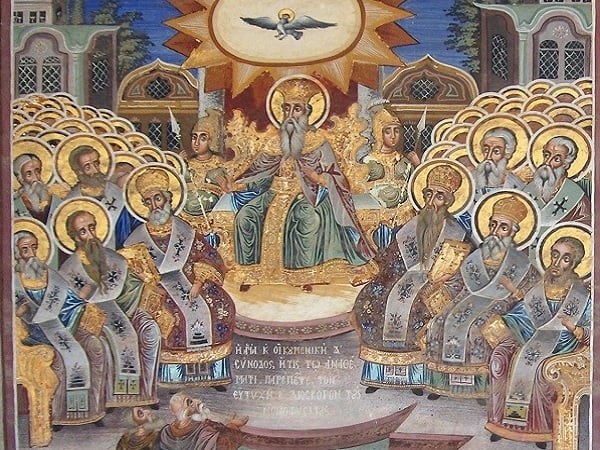The Fourth Ecumenical Synod (Metropolitan Ierotheos of Nafpaktos and Ayios Vlasios)
16 Ιουλίου 2018
The 3rd Ecumenical Synod dealt with the heresy of Nestorios, the Patriarch of Constantinople. It condemned him and defined the faith as regards the theanthropic Christ and Our Most Holy Lady the Mother of God. This was after an agreement, known as the Formula for Reunion, was reached in 433 between Saint Cyril of Alexandria and John of Antioch.
After the demise of these two Patriarchs, however, their fanatical disciples re-opened the issue, in the belief that both of them had retreated from their previously-held positions, and this caused a number of problems for the Church.

One of the protagonists was Eftykhis (Eutyches) who taught that our Lord Jesus Christ did, indeed, have two natures, before they were unified, but recognized only one after unification had taken place. In other words, it was his belief that after the union of the two natures, Christ’s human nature was absorbed by His divine nature. This problem continued because there was further confusion between nature and person, since it was considered that one person was linked to one nature.
And so the 4th Ecumenical Synod was called in Chalcedon, in 451, at the behest of the imperial couple, Pulcheria and Marcian. It was chaired by Patriarch Anatolios of Constantinople and representatives of Pope Leo of Rome. This Synod confirmed the decision of the 3rd Ecumenical Synod and, ‘following the earlier Fathers’, as it writes, accepted that the Word is one Person and one Hypostasis, ‘known in two natures without confusion, without change, without division and without separation’ and that nowhere is the difference between the two natures removed, bur rather the specific character of each nature is preserved in the union of the Word in one Person-Hypostasis.
This whole issue may seem philosophical and of little concern for the theology of the Church, but this is not the case, for the following reasons.
Through their study of Holy Scripture, the Old and New Testaments, and, in particular Christ’s revelation of Himself to the Apostles, the Fathers of the Church knew that Christ was truly God, Who had become incarnate in order to defeat death, sin and the devil. In the River Jordan, the existence of the Holy Trinity became clear. On Mount Tabor, Christ’s face shone like the sun and His garments were as white as light. The pillar of light also engulfed the Disciples and the voice of the Father was heard. This light was not created, but divine, uncreated; it was the light of the Godhead. In Christ there was human nature, (body and soul), but from within came the effulgence of the Divinity. This light was not another nature, but the divine nature which was united to human nature in Christ. In this way, Christ’s divinity was revealed, though His human nature was not abolished. This is what led the Fathers to declare that the two natures- human and divine- act in the hypostasis/person of the Word ‘without confusion, without change, without division and without separation’.
This was the experience shared by many of the Fathers of the Church, as we see clearly in Saints Basil the Great, Gregory the Theologian and many other later Fathers such as Saints Symeon the New Theologian, Saint Gregory Palamas and others. This is why the experience and faith of the Fathers is identical with that of the Prophets and Apostles.
And besides, they did not make this formulation in order to express a logical position concerning Christ, because this mystery cannot be understood logically. Nor did they do so in order to develop a particular philosophy, but rather to respond to the heretics of the time, who did, indeed, philosophize. The heretic theologians attempted to understand this mystery in terms of philosophy, while the Fathers used some of its terms, such as essence, nature, person, and hypostasis, in order to answer the heretics and to deconstruct their philosophical mode of thought.
As Saint Gregory Palamas says, this means that dogma is the manifestation/revelation of the Word of God- without flesh to the Prophets in the Old Testament and in the flesh to the Apostles in the New Testament. The terms, on the other hand are words, lexical items, which are used by the Fathers to guard dogma, the revelation of the Son and Word of God. For this reason, the terms define the line between the truth and error.
As is the case with the decisions of the other Ecumenical Synods, the Church has made those of the 4th into hymns to be sung at services. They’ve also become prayers and in this way dogma- the terms of the Ecumenical Synods- is closely linked to the worship of the Church. This is an indication of the importance of worship, at which we confess and experience Christ as God and Man.





